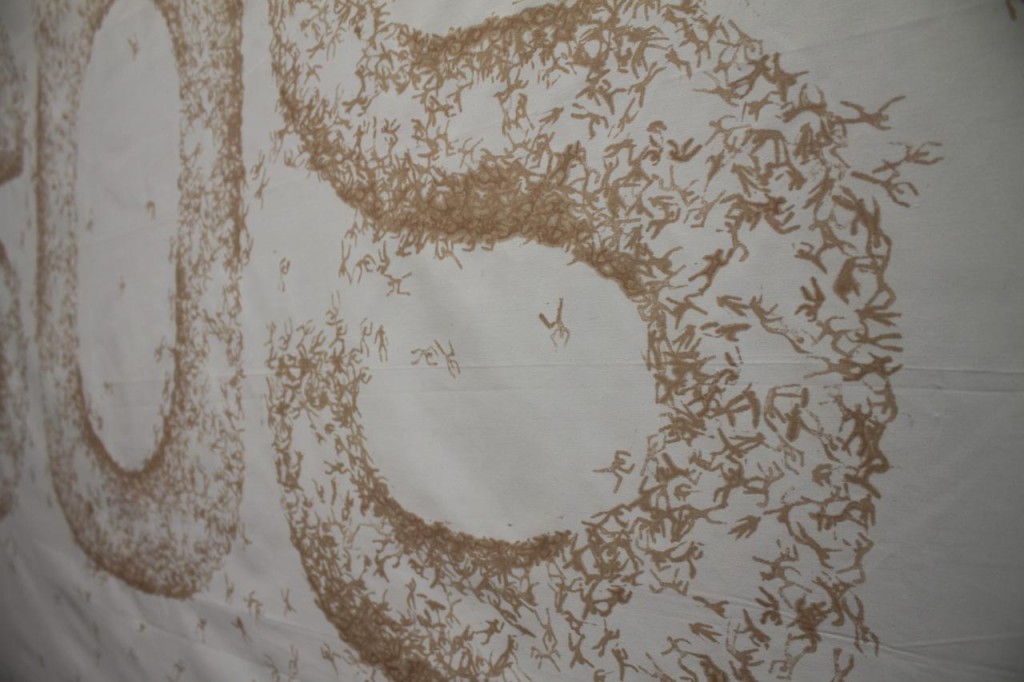State Of The Arts: Fort Worth Artist Bernardo Vallarino
ArtandSeek.net July 20, 2018 27This week in State of the Arts, Anne Bothwell talked with Columbian-American mixed-media sculptor and installation artist Bernardo Vallarino about his latest work “Simpatia sin Compasión” on view at Fort Worth Community Arts Center. It addresses our perceptions of refugees and immigrants – as both vast numbers and as individuals.
And Vallarino used a rather unusual ink to create it.

These pieces are huge. They are big banners with Spanish phrases on them like, “No Mas,” and “Tu y Yo.” And when you get up close to them you realize that these words are made of tiny stamps of human figures. Can you tell me what inspired this?
Within my body of work, I tried to work within a macro and micro context. In other words, when you’re far back you are able to see and experience the artwork in one way, and then as you get closer you’ll get more information. So, in this case, you have the large banner with the large words like –“Tu y Yo,” “No Mas,” but as you get close then you realize that you’re not looking at shadows or thoughts, but rather humanoid figures.
What do those forms stand for?
Individuals. But at the same time, individuals without any identity. So they are blank forms for you to be able to empathize with.
You’re making these figures–these stamped figures–and instead of dipping the stamp in ink you’re using sacramental wine. What does that signify to you?
Originally I wanted to use human blood. I wanted to be fairly blunt on what I was trying to say. But, getting a hold of human blood is very, very difficult, and using my own blood would just kinda talk about a self-portrait and that’s really not what I wanted to do. So, within a conversation of waiting for friends, the idea of sacramental wine came about and of course, it would be extremely difficult to get a hold of that material, but through the conversation, somebody had a heart for what I was trying to say, and a few weeks later I actually had a box in my mail that had the wine. And in it it said, “for this purpose, for this artwork.” So I ended up able to have the sacramental wine.

And what does that signify to you?
As a Christian and as a Catholic it is the blood of Christ for us. It’s the context of humanity, but also the cleaning of the sin. It switches back and forth the context of the words, like “you and I.” So when you have “you and I” placed within the context of sacramental wine what is it saying now? Are you connecting to “you and I”? As you get closer and you understand the material and you really study the piece and you get into this really nice area of the artwork that I’m hoping people can see. If they really choose to see them.
One of the things that’s so striking about these thousands and thousands of small figures–it almost seems like a metaphor. Are you trying to say that we’re not seeing people as individuals?
In many ways. Yes. Definitely. One of the things that I also want to point out in this whole body of work is the fact that when you take an element or an individual element and you put it into a context of a lot that individually gets lost, its value gets lost. So just like the context of quote, unquote “refugees” as a whole, but when you closer, when you start studying the individual then you realize there’s something much more special about that individual.
And you have a piece in this show that actually specifically addresses the refugee experience. Can you describe that?

Bernardo Vallarino
As I was working with refugees one of the things that I heard a lot about was a connection to those left behind. Now, I myself coming from Columbia completely understand that, but it was highlighted as I did those interviews. So it is another banner, another protest banner that reads out “Sin Ti,” which mean without you. And the way it works is we have the refugees–not the refugees–but the migrants coming in and put in the names of people coming who they left behind together with stamps and then stand directly within those words so at the end we will have the word “Sin Ti” filled with a memorial of people basically that were left behind. Whether they were family, friends, neighbors.
And they are called protest banners. Are they actually going to be used in a protest?
I never had thought about using them directly as a protest mainly because of the context of the material. When I was making them I used holy water and I anointed myself, and I crossed myself before I started working with the material. And I after finishing with the material I washed my hands. I have a high reverence for the sanctified wine. So, yes they are protest banners, but I do think the protest can be done inside of the building just because of the reverence of the materials.
Can you explain the title of your show?
Sure. Simpatia sin Compasión. So, sympathy is a word that describes a shared feeling. So, sympathy meaning, I understand what you are going through. I empathize with you in a way. But compassion requires action. Compassion requires the next level for you to act on it. So, sympathy without compassion just basically means that. I feel what you’re feeling, I understand what you’re going through, but literally I’m not doing anything about it. So, I, in some sort of way, I’m trying to tell people, “Hey, we need to do something.”










